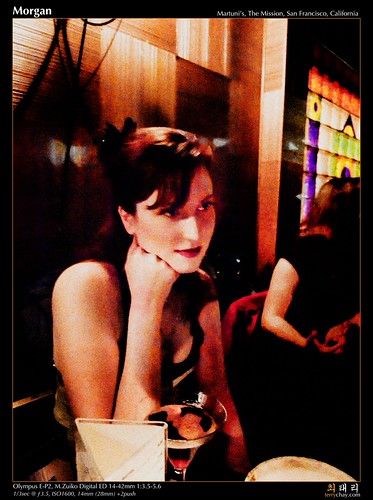From a previous article, I finally found a way to work in Aperture again. But since I’m also trying to pick up photography again, I thought it’d be fun to write a little bit showing a few experimental images taken from that day.
This will be a way to test out a new WordPress plugin I just wrote to do mouseovers. As long as you’re on this blog article, you can run your mouse over the image to see the pre-processed original image.

The specials are…
Mission Beach Cafe, The Mission, San Francisco, California
Olympus E-P2, M. Zuiko Digital ED 14-42mm 1:3.5-5.6
1/5sec @ ƒ3.9, iso 1600, 17mm (35mm)
I arrived a little late as usual, but just in time to order dinner with everyone else.
This was actually the first image I used to test out whether the workflow works. Because of that, the DNG output was 8-bit, not 16-bit. That may have accounted for the overaggressive smoothing, or it could be the lack of dynamic range in an ISO 1600 µ4:3 CMOS sensor (roughly 1/4 the size of a 35mm frame). Then again, maybe it’s the setting on Topaz Adjust plugin. In any case, it does have the painterly look that you get when you start remapping dynamic range of an image. Not too sure if I can still call this a photograph.
If you mouseover the image, you may be wondering how I pulled color from the black-and-white original. The original is the JPEG, but the image was generated from the RAW. For documentary photography, on cameras which resemble rangefinders like the Leica M8 and the Olympus E-P2, I prefer black-and-whites previews, which force me to concentrate on tone and not color—but it’s always nice to be able to grab the color channels from the RAW if I change my mind.
This exposure tests the outer-limits of the kit lens: 1/5 of a second at a borderline too-high-for-this-camera ISO at the largest aperture for this 35mm EFL. Had I my old 17mm pancake, I’d have gotten a full stop faster. Still, it got focus-lock and the in-body image stabilization allowed me to shoot handheld braced against elbows on the table. Yeah!
More photos in later pages…







